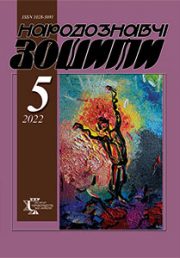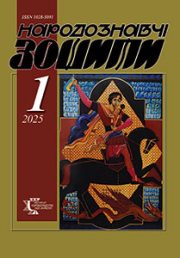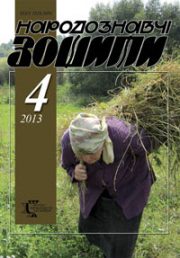The Ethnology Notebooks. 2022. № 3 (165), 622—632
UDK [930.2:316.3-058.34](410)”18″
DOI https://doi.org/10.15407/nz2022.03.622
EVERYDAY EXPERIENCE OF WORKHOUSE’S RESIDENTS OF VICTORIAN ENGLAND
PIDLIASKYI Orest
- ORCID: https://orcid.org/0000-0002-5214-4351
- Student of the master’s program «History and Archeology»
- The Ivan Franko National University of Lviv,
- Department of Modern and Contemporary History of Foreign Countries,
- 1, Universytetska str., 79000, Lviv, Ukraine,
- Contacts: е-mail: pidlyaskiy2@ukr.net
Abstract. Introduction. The problem of poverty and the fight against it was relevant in Britain in the XIX-th century, as it developed rapidly economy and industry, which in turn increased social inequality and poverty. One of the main ways to combat poverty at that time were Workhouses which aimed to «re-educate» the poorest classes of the population through hard physical labor and strict discipline.
Problem Statement. After the legislative reform of 1834, stricter rules and regulations began to be introduced in the Workhouses throughout the country, which made life much more difficult for the poor who found themselves there. Inadequate treatment of residents by staff was not uncommon and had not been addressed at the state level for a long time. However, the paupers themselves could often deliberately disturb the order in the Workhouses in order to improve their conditions.
Purpose. In the article on the basis of digitized archival records Commissions for the poor is analyzed the daily experience of the inhabitants of the English Workhouses.
Methods. The general scientific methods of analysis and synthesis, as well as special scientific comparative-historical and chronological methods are used in the work. The author adheres to the principle of historicism. Also was used the method of «total institutions» of the Canadian sociologist Irwin Hoffman.
Results. It was found that the main problem of Workhouses was not so much the living conditions as the deindividualization and dehumanization of the inhabitants of these institutions. The same uniform, strict agenda, lack of personal space, all these attributes haunted the Workhouses during the XIX-th century and have not been resolved to the end.
Conclusion. Workhouses were one of the most controversial aspects of British social policy in the XIX-th century. The reform of 1834, which introduced the practice of providing assistance to the poor exclusively in Workhouses, was often criticized and further tried to supplement.
Strict regulation of daily affairs, uniforms, system of punishments and rules of conduct — all were everyday and traumatic experiences of residents.
Keywords: British social policy, poverty, pauperism, Victorian England, workhouses, history of everyday life.
Received 4.05.2022
REFERENCES
- Rose, M. (1986). The Relief of Poverty, 1834—1914. Manchester: Macmillan Education Ltd.
- Seal, C. (2009). Poor Relief and Welfare: a Сomparative Study of the Belper and Cheltenham Poor Law Unions, 1780 to 1914. Leicester: Centre for English Local History University of Leicester.
- Humphreys, R. (1995). Sin, Organized Charity and the Poor Law in Victorian England. London: Macmillan Press Ltd.
- Charlesworth, L. (2010). Welfare’s Forgotten Past, A Socio-Legal History of the Poor Law. New York: Routledge.
- Hallas, C. (2000). Poverty and Pragmatism in the Northern Uplands of England: the North Yorkshire Pennines, 1700—1900. Social History, 25, 67—84.
- Charles, H. (1998). Feinstein. Pessimism Perpetuated: Real Wages and the Standard of Living in Britain During and After the Industrial Revolution. The Journal of Economic History, 58 (3), 625—658. Retrieved from: http://piketty.pse.ens.fr/files/Feinstein1998.pdf (Last accessed 21.11.2021).
- Crowther, A. (1981). The Workhouse System 1834—1929. The History of an English Social Institution. London: Batsford Academic.
- William, N., & Chadwick, E. (1909). Poor Law Commissioners’ Report of 1834. The Commissioners for Inquiring into the Administration and Practical Operation of the Poor Laws. London. Retrieved from: https://oll-resources.s3.us-east-2.amazonaws.com/oll3/store/titles/1461/0169_Bk.pdf (Last accessed 21.11.2021).
- Williams, S. (2020). Paupers Behaving Badly: Punishment in the Victorian Workhouse. Journal of British Studies, 59, 764—792. Retrieved from: https://www.campop.geog.cam.ac.uk/research/projects/workhouses/ (Last accessed 01.12.2021).
- Seal, C. (2010). Workhouse Populations in the Cheltenham and Belper Unions: a Study Based on the Census Enumerators’ Books, 1851—1911. Family & Community History, 13 (2), 83—100. Retrieved from: https://www.tandfonline.com/doi/abs/10.1179/146311810X12851639314075 (Last accessed 01.12.2021).
- Harley, J. (2015). Material Lives of the Poor and their Strategic Use of the Workhouse during the Final Decades of the English Old Poor Law. Continuity and Change, 30, 71—103. Retrieved from: https://www.cambridge.org/core/services/aop-cambridge-core/content/view/ D2677C2CDD51E862B92A7811A1B5026C/S0268416015000090a.pdf/material-lives-of-the-poor-and-their-strategic-use-of-the-workhouse-during-the-final-decades-of-the-english-old-poor-law.pdf (Last accessed 01.12.2021).
- Sclater, W. (1836). A Letter to the Poor Law Commissioners of England and Wales on the Working of the New System. Basingstoke.
- Baxte, W. (1841). The Book of the Bastilles, or the History of the Working of the New Poor Law. London.
- Newman, C. (2014). To Punish or Protect: The New Poor Law and the English Workhouse. International Journal of Historical Archaeology, 18 (1), 122—145. Retrieved from: https://www.jstor.org/stable/24572708 (Last accessed 03.12.2021).
- Green, D. (2010). Pauper Capital: London and the Poor Law, 1790—1870. London: MPG Books Group. Retrieved from: https://pdf.zlibcdn.com/dtoken/075dd0c8e089321324e311110178b2ea/Pauper_Capital_London_and_the_Poor_Law,_1790-1870_2573540_(z-lib.org). pdf (Last accessed 03.12.2021).
- Mahon, J. (1835). The Poor Laws as They Were and as They Are, or Recent Alterations in the Poor Laws by the Statute. London.
- London, J. (1907). The People of the Abyss. New York: Grosset & Dunlap.
- Brundage, A. (2002). The English Poor Laws, 1700—1930. Basingstoke.
- Jones, P., & King, S. (2020). Pauper Voices, Public Opinion and Workhouse Reform in Mid-Victorian England. Cham: Palgrave Macmillan. Retrieved from: https://link.springer.com/book/10.1007%2F978-3-030-47839-1#about (Last accessed 10.12.2021).
- Green, D. (2006). Pauper Protests: Power and Resistance in Early Nineteenth-Century London Workhouses. Social History, 31 (2), 137—159. Retrieved from: https://www.jstor.org/stable/4287329 (Last accessed 08.12.2021).
- Alistair, E. (2014). Medical Care in the Workhouses in Birmingham and Wolverhampton, 1834—1914. Birmingham: University of Birmingham.
- (1845, august 16). Andover Union: Horrible Disclosures. Northern Star (P. 14). Retrieved from: https://www.britishnewspaperarchive.co.uk/viewer/BL/ 0000091/18450816/042/0014?browse=true (Last accessed 15.12.2021).
- Miller, I. (2013). Feeding in the Workhouse: The Institutional and Ideological Functions of Food in Britain, 1834—70. Journal of British Studies, 52, 940—962.
- (1837). Second Report from the Select Committee on the Poor Law Amendment Act, Reports of Committees. London.
- (1837). Seventh Report from the Select Committee on the Poor Law Amendment Act, Reports of Committees. London.
- (1835). Annual Report of the Poor Law Commissioners for England and Wales. London: W. Clowes and Sons. Retrieved from: https://books. google.com.ua/books?id=Ho0SAAAAIAAJ&printsec=frontcover&hl=uk&source=gbs_ge_summary_r&cad=0#v=onepage&q&f=false (Last accessed 22.12.2021).
- (1865, july 1). The Lancet Sanitary Commission for Investigating the State Infirmaries of Workhouses. The Lancet. Retrieved from: https://www.sciencedirect.com/science/article/abs/pii/S0140673602398891 (Last accessed 25.12.2021).
- Townsend, P. (1962). The Last Refuge: a Survey of Residential Institutions and Homes for the Aged in England and Wales. London: Routledge And Kegan Paul.
- Goffman, E. (2019). Total Institutions. Essays on the social situation of mentally ill patients and other inmates of closed institutions. Moscow: Elementary Forms. Retrieved from: https://socioline.ru/files/5/309/ goffman_e._-_totalnye_instituty_-_2019.pdf (Last accessed 29.12.2021) [in Russian].







